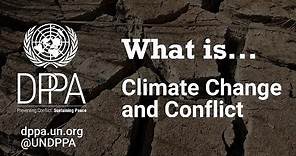Analyzing the Relationship between Climate Change and Global Conflicts
Climate change, once considered a purely environmental issue, is now widely recognized as a critical driver of global conflicts. Rising temperatures, shifting weather patterns, and extreme climate events are exacerbating existing vulnerabilities, creating fertile ground for tension and violence. From resource scarcity to mass migration, climate change influences the dynamics of human societies and, consequently, the likelihood of conflict.
This article explores the complex relationship between climate change and global conflicts, highlighting the mechanisms through which environmental changes impact political, social, and economic stability.
Climate Change as a Threat Multiplier
The concept of climate change as a “threat multiplier” has gained prominence in recent years. This term refers to the way climate change exacerbates existing social, political, and economic challenges, increasing the likelihood of conflict. Vulnerable regions with pre-existing issues, such as poverty, weak governance, and ethnic tensions, are particularly susceptible to climate-induced instability.
1. Resource Scarcity
- Water Stress: Climate change has led to declining freshwater availability in many regions. Melting glaciers, prolonged droughts, and over-extraction of groundwater are intensifying competition for water resources. Conflicts over rivers and shared water bodies, such as the Nile, Indus, and Jordan basins, have historically been sources of tension.
- Food Insecurity: Changing weather patterns are disrupting agricultural cycles, leading to lower crop yields and food shortages. The resulting economic hardships can fuel grievances, spark protests, and lead to violent uprisings.
2. Displacement and Migration
- Climate-induced displacement is a growing concern. Rising sea levels, desertification, and extreme weather events are forcing millions to leave their homes, often in search of better living conditions.
- The influx of climate migrants into already strained urban areas or across national borders can heighten tensions between communities and create conflict over resources and jobs. For instance, the Syrian civil war has been partially attributed to prolonged droughts that displaced rural populations into urban centers.
3. Economic Shocks
- Natural disasters, such as hurricanes, floods, and wildfires, cause significant economic damage. In developing countries, where resilience is low, such events can destabilize governments, undermine development, and create power vacuums that are exploited by insurgent groups.
Case Studies Linking Climate Change and Conflict
1. The Syrian Civil War
- Syria experienced one of the worst droughts in its history from 2006 to 2011, which devastated agriculture and displaced millions of rural farmers to urban areas. The strain on resources and infrastructure, combined with political mismanagement, contributed to social unrest and protests that eventually escalated into a full-blown civil war.
2. The Sahel Region
- The Sahel, a semi-arid region in Africa, has witnessed increasing violence between farmers and herders. Rising temperatures and erratic rainfall patterns have reduced arable land and water availability, intensifying competition over these scarce resources. Extremist groups, such as Boko Haram, have exploited these tensions to recruit members and expand their influence.
3. South Asia
- In South Asia, shared river systems like the Indus and Ganges have been sources of tension between neighboring countries. Climate change-induced reductions in water flow are heightening disputes over water-sharing agreements, particularly between India and Pakistan.
Mechanisms Connecting Climate Change and Conflict
To understand how climate change translates into conflict, it is essential to explore the mechanisms at play:
1. Environmental Degradation and Livelihood Loss
- Environmental degradation, such as deforestation, soil erosion, and desertification, undermines livelihoods, particularly in rural areas dependent on agriculture and natural resources. This creates economic hardship and social discontent, which can escalate into violence.
2. Weakened State Capacity
- Climate-related disasters can overwhelm governments, diverting resources away from development and security toward disaster response. Weak governance and corruption exacerbate the inability to address the root causes of unrest, leading to prolonged instability.
3. Increased Competition
- Scarce resources, whether land, water, or food, are often unevenly distributed. This can create power struggles between different groups, particularly in regions with historical ethnic or religious divides.
4. Humanitarian Crises
- Extreme weather events often result in humanitarian crises, straining international aid systems. Refugee camps and displaced populations are particularly vulnerable to exploitation by armed groups, further perpetuating cycles of conflict.
The Role of Climate Policies in Preventing Conflicts
Given the link between climate change and global conflicts, proactive policies and interventions are crucial. Key areas of focus include:
1. Climate Adaptation and Resilience
- Investments in climate-resilient infrastructure, such as flood defenses and drought-resistant crops, can help reduce vulnerability to climate shocks.
- Community-based adaptation programs that empower local populations to manage resources sustainably are vital in addressing the root causes of conflict.
2. International Cooperation
- Transboundary resource management agreements, particularly for shared water bodies, are essential to preventing disputes between nations.
- International climate finance, such as the Green Climate Fund, plays a critical role in supporting developing countries to cope with the impacts of climate change.
3. Conflict-Sensitive Climate Action
- Climate policies must account for potential conflict risks. For example, large-scale renewable energy projects should ensure that local communities benefit and are not displaced.
4. Strengthening Governance
- Building strong, transparent institutions capable of managing natural resources and addressing grievances is essential to reducing the risk of climate-induced conflicts.
Challenges in Addressing the Climate-Conflict Nexus
While the link between climate change and conflict is increasingly recognized, addressing it remains challenging:
- Complex Interactions:
Climate change is rarely the sole cause of conflict; it interacts with political, economic, and social factors in complex ways. This makes it difficult to attribute conflicts directly to climate change and design targeted interventions. - Lack of Data:
Comprehensive data on climate impacts and conflict dynamics is often lacking, particularly in fragile states. This hampers the ability to design evidence-based policies. - Short-Term Focus:
Governments often prioritize short-term economic growth over long-term climate resilience, delaying critical investments in adaptation and mitigation.
The Way Forward
To effectively address the climate-conflict nexus, a multidimensional approach is needed:
- Integrating Climate and Security Policies:
Governments and international organizations must recognize climate change as a security issue and integrate it into conflict prevention and peacebuilding efforts. - Promoting Sustainable Development:
Ensuring equitable access to resources, reducing poverty, and promoting inclusive economic growth can help build resilience to climate-induced shocks. - Enhancing Global Solidarity:
Climate change is a global challenge that requires collective action. Wealthier nations must fulfill their commitments to support vulnerable countries through financial aid and technology transfer.
Conclusion
The relationship between climate change and global conflicts is a stark reminder of how deeply interconnected environmental, social, and political systems are. As climate change accelerates, the risks of resource scarcity, displacement, and economic shocks will continue to grow, threatening global stability.
Addressing this challenge requires a proactive, collaborative approach that combines climate action with conflict prevention strategies. By building resilience, strengthening governance, and fostering international cooperation, we can mitigate the risks of climate-induced conflicts and pave the way for a more stable and sustainable future.


